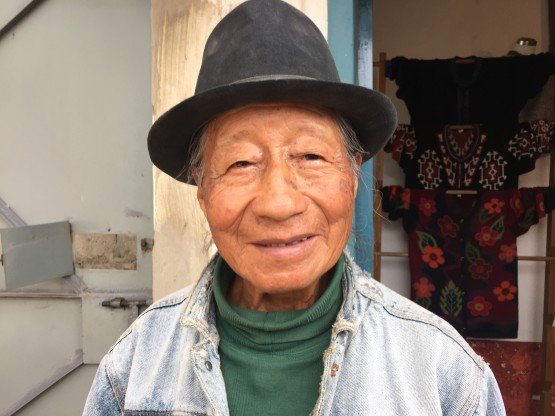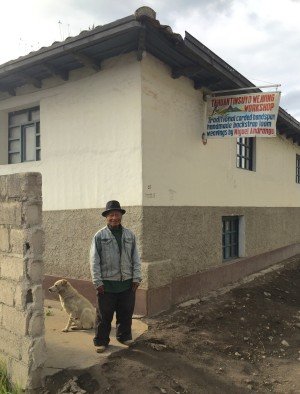We visited the home and workshop of Miguel Andrango, 81, described as Ecuador’s master weaver, on Monday November 9, 2015. Senor Andrango welcomed us with a few words of English and many smiles. He walked us through the process of cleaning, preparing, and dyeing wool for spinning into thread and then handweaving into fabric using a backstrap loom, technology in use for thousands of years.
His workshop had bare concrete walls and a floor of large, rough bricks covered at one spot by a woven straw mat. He sat on a bench beside baskets of raw wool and scraped the wool between two handheld carding tools. The scratchy sound was rhythmic and calming, punctuated by birds singing outside. He checked the wool and added a bit more, then continued carding. Andrango then moved to a long spinning wheel in use since his great-grandfather’s time. Prepared wool in a basket was drawn up to a rod where it was twisted into yarn when he gently began the spinning by pulling a wire, then accelerating the motion by turning a large wheel at the other end, about 20 feet away from where the yarn was collected. At full speed, the yarn formed in a blur from the rough feed of the wool from the basket.
In bearing, energy, and humility Miguel Andrango brought to my mind a little old Zen master, a teacher of life as well as weaving. As he walked back and forth between the big turning wheel of the spinner to where the raw wool was drawn onto the spindle, he appeared to forget that three tourists from the U.S. were watching him. His hands and eyes were all on the machine and the material. There was something so practiced, so flawless about his movements that he seemed to disappear into them, and so did we.
Out in the courtyard of his home and workshop, he showed us where he hangs wool to dry after dyeing with natural substances like walnuts and seeds. He is no more than five feet tall, and he smiled as he pointed to the clothesline, saying it was low enough for him to reach. He wore a black fedora hat, turtleneck shirt and a frayed light denim jacket. His straw sandals were homemade.
Yes, there was a gift shop, and we were eager to find items to purchase, in support of Andrango’s craft and for remembering our visit. In our enthusiasm, we made some incorrect assumptions about what we were buying. A handsome sweater that I bought, which I thought he had made himself, turned out to be an import from Peru, and Darlene’s colorful wool bag is from Bolivia. But I’m confident that the coarse guitar strap that I purchased was made by Miguel Andrango in his workshop, or perhaps by someone else in his family. The confusion was entirely ours; our host made no representations, in English or Spanish, that all of the work on sale had been made in his shop.
It’s difficult to explain the effect that visiting Miguel Andrango had on Darlene, Deb and me. His age and size were probably part of it, but the main source was the kindness of his smile. He greeted us as if we were the first people who had ever found his workshop on a hill outside Otavalo in the Andes of Ecuador, as if he had been waiting for us for a long time. There was nothing tired or bored about his demeanor. He was lit up with years of creating beautiful things the way they have been created for thousands of years.
We hear his family is involved in the work now, perhaps bending it toward more commercial focus. But it seems clear that when he is gone a way of weaving will be gone with him. This makes us very glad we had a chance to meet him and to appreciate his craft in person.


